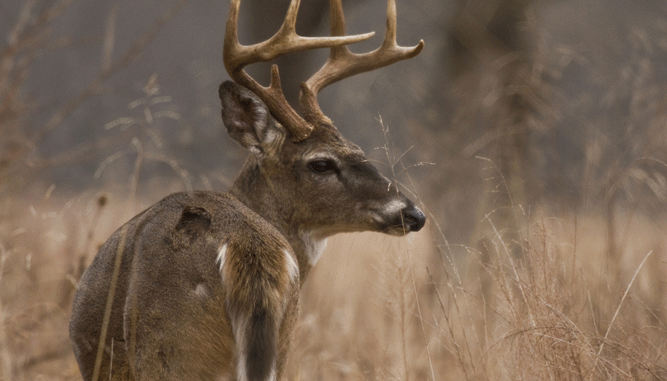
Blackpowder season and the peak of the rut coincide across much of North Carolina this month. Here’s how to take advantage.
With apologies to those waiting for Dec. 25, Christmas arrives in November every year for deer hunters in North Carolina.
According to the N.C. Wildlife Resources Commission, the 11th month is when hunters harvest the majority of the year’s whitetails — and the most trophy bucks.
The reason is obvious to most deer chasers — no, that’s not a shot of Jack Daniels gulped after a cold beer. November is when the peak of the rut or breeding season occurs across most of the state. That means bucks wander around most of the month, trying to find receptive girlfriends. It’s nature’s way of making sure there will be plenty of fawns come next spring.
Whitetail does usually birth multiple fawns, so even with a large hunter kill — last year’s total of 175,157 registered deer was the second-highest in state history — it’s certain North Carolina won’t be lacking in whitetails for years to come, even though each year we turn boxcar loads of bucks and does into venison.
Most experts agree the peak of the rut appears first in the southeastern corner of the state at the end of October, spreads north to the rest of the coastal plain the first week of November, travels west into the Piedmont the second week of November and begins at the mountains the week of Thanksgiving.
But no matter when the mating season begins, most hunters have learned certain techniques for chasing swollen-necked bucks this month. Time-honored approaches to increasing one’s chances of putting a big rack on the living-room wall include hunting scrapes or rub lines, using rattling horns and grunt calls, employing scent lures and setting stands near food plots or other places where does concentrate.
Those are all good tactics, but they’re not the only tactics.
Here are accounts from three hunters who found different ways to bag that trophy of a lifetime:
Shannon Wilson, 40, lives in the Hightower community of Caswell County, a few miles south of Yanceyville, where he operates a body shop with his brother and father. His location is in the middle of one of the prime big-buck areas of the northern Piedmont.
“We have a lot of deer here and some big ones,” he said.
In Nov. 2009, Wilson’s 11-year-old son, Clay, killed a 10-point monster.
“I took a lot of ribbing that my son had killed a bigger buck than I ever did,” Shannon Wilson said, “but I didn’t mind; I was with him, and it was a bigger thrill for me to see him shoot that buck than me.”
On Nov. 10, 2010, a year and day after his son dropped his buck with one shot from a Black Knight 50-caliber muzzleloader, Wilson was sitting in a tree stand overlooking two cornpiles in a creek bottom between hay fields surrounded by cutover land.
“It was the peak of the rut here,” said Wilson, who was in a 2-man buddy stand 17 feet above the forest floor.
“I had the best of both worlds at that location: the land’s mostly cutover with some wheat fields, and we put out lots of corn,” Wilson said.
It was about 8:30 a.m., with clear skies and mild weather. A few minutes earlier, he’d spied a 4-pointer on a cornpile in the creek bottom. Then, the sun rose over a ridge, and Wilson, facing east, was temporarily blinded by its glare.
“I’d seen three or four areas along the creek bottom that had big rub trees, so I felt like a big deer was using that area, although we’d never got (a photo) on a trail camera,” he said.
Then Wilson saw movement along the edge of a cutover beyond the creek bottom. He put his scope on a deer standing approximately 400 yards away and spied a large rack.
“I didn’t know what he’d do, so I climbed down (from his stand),” Wilson said.
Putting “three or four” big rub trees between him and the buck, Wilson began a stalk toward the animal. He covered the distance quickly, passed the rub trees and stayed behind some ground cover. Then he peaked around a bush.
“He was about 75 or 80 yards from me,” Wilson said. “I sat down behind a bush I could see through, but he was facing away from me so I couldn’t shoot. For some reason, he turned around and started walking straight toward the rub trees — and me.”
With his Pursuit LT 50-caliber at his shoulder, Wilson slipped off the safety and was ready.
“He actually walked on the other side of the bush from me and stopped 10 steps away,” he said. “I shot him in the neck while I was looking at the iron sights — not in the scope — because he was so close. He fell straight down and never moved.”
The buck’s rack, a main-frame 5×5, had 11 scoreable points, including one 1½-inch kicker point. The second tines on each beam measured 12 inches long, and the third tines were both11 inches long. At the Dixie Deer Classic in Raleigh last March, the buck’s rack netted 149-1/8 Boone & Crockett points, grossing 158-1/8.
“The fields are planted in wheat the farmer gets up for hay, so we put out corn,” Wilson said. “I believe in corn. I don’t use deer scents, and I tried grunting, but it didn’t work for me.”
Wilson, his brother and father put out 6,000 pounds of corn each year, he said.
“I just like hunting muzzleloader season better than any other time because I think you got a better chance of killing a big one,” he said. “Most of the time (bucks) are in the rut during muzzleloader.
“This place is good because of all the cutovers; that’s where the deer bed. We hunt the creek bottoms because they’ve got a lot of trails, and deer travel the creek going to and from the fields. That’s why we put corn at the creek bottoms.”
Scotty Morris, a Person County resident, doesn’t stop hunting after bow season ends.
“I’ve always been a bow and muzzleloader hunter,” Morris said. “I love hunting during November because that’s when bucks are moving around because of the rut.”
However, Morris said he totally believes in using corn to draw bucks into shooting range.
“I know some people say you can’t kill big deer over cornpiles, but that’s not what’s happened for me,” he said.
It’s not so much that Morris believes that only corn will lure trophy bucks into range, but it’s the best tool he’s found to get deer photographs with trail cameras. And he doesn’t hunt an area unless he’s first seen a digital trail-cam photo of a big buck.
“I simply don’t hunt an area without a camera, and all the deer I’ve killed have had their pictures taken at cornpiles,” he said.
In addition to a 162-inch monster he killed this past September, he took a 150-inch class buck in 2009 and a Pope & Young buck last year while hunting cornpiles where his cameras previously had snapped photos of the deer.
“I know deer go to acorns, and people kill big bucks at oak trees, but I’ve never killed a big deer over acorns,” he said.
Another factor makes him use cornpiles.
“Where I hunt, there aren’t any trees,” Morris said. “It’s all cutover; the only way I can draw ‘em out of the cutovers to get their pictures or hunt them is with corn.”
Morris uses Stealth, Moultrie and Cuddeback trail cameras.
“I think Stealth cameras are best for cornpiles, but this is just my opinion,” he said. “The Stealth uses a regular flash (during low-light conditions), not the red-colored (infrared) flash. Some pictures I’ve got (deer) appear to be running from the flash, so I think red-flash cameras may spook ‘em.
“I think (deer) may believe a regular flash is lightning, which they’re used to seeing.”
Morris places trail cameras at eight locations. Last year, he also spread corn from 258 50-pound bags.
“It’s expensive now at $10 a bag,” Morris said. “The last I bought I got from a farmer for $6.50 a bag, but I’m about to run out now.”
He begins distributing corn (two 50-pound bags each two days) at eight different areas starting in mid-August to get deer accustomed to coming to his spots. He continues his feeding schedule during hunting season.
“By the time (archery) season opens, I’ll have it narrowed down to five or six spots where my cameras have got pictures of bucks I want to hunt,” he said.
Morris never hunts in the woods, instead preferring fields.
“I can drive up to a spot with corn in my truck and put out the corn without leaving scent,” he said. “I use rubber boots when I’m corning a place, just like when I’m hunting.”
Darren Jenkins of Snow Camp might agree with many hunters who believe in the luck factor, the “I’d rather be lucky than good” factor.
But luck is only effective if a hunter puts in the time, and November is the best time to be outside.
That’s basically what happened for Jenkins on Oct. 30, 2010, the first day of muzzleloader season in the Central deer section.
“I was employed at the time with a surveying company but got laid off,” said Jenkins, 27, who is now a Burlington fire-fighter. “So I had plenty of time on my hands.”
He didn’t own a blackpowder rifle, but his brother, Derrick, loaned him a .50-caliber CVA smokepole. and he headed to a 34-acre family farm the brothers had hunted since before they were teens. The farm featured an old barn next to a hayfield surrounded by cutovers.
“I’d killed one little 6-pointer a couple years earlier,” Jenkins said. “That’s the only other deer I ever shot. After I got married, I just didn’t have time to go (hunting).”
The farm was empty of trees, as timber crews had clear-cut the property several years earlier.
“It’s just one hay field and a lot of cutover,” Jenkins said.
That afternoon just before dark, as Jenkins sat in the barn’s hay loft, a buck entered the field about 20 yards away.
“Wasn’t much to it,” he said. “I put the crosshairs on the buck’s shoulder at 10 yards; he was standing broadside to me.”
After Jenkins pulled the trigger, he saw the deer bound into the cutover. It fell 20 yards inside the thicket.
“I didn’t really know how big (the antlers were) until a neighbor, Randy Thompson, came and helped me get him out,” Jenkins said.
The big whitetail sported a nearly perfect 5×5 typical rack with 11-3/8- and 11-6/8-inch G2s, main beams of 26 4/8 and 25 inches, and only 5-1/8 inches of deductions.
The best typical buck from North Carolina taken by a blackpowder hunter last year, Jenkins’ deer netted 156-6/8 points and grossed 161-3/8.
“I got a new muzzleloader for Christmas, and you can believe I’ll be hunting more from now on,” Jenkins said.
So the lessons of these three successful hunters seem clear:
• Use trail cameras to detect worthy bucks;
• Use corn to concentrate bucks;
• Take care to leave as little scent on the ground as possible;
• Hunt as often as possible; spending time in the woods increases your chances.

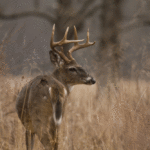
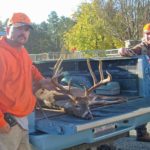
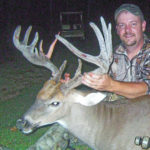
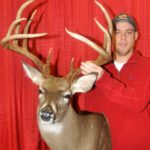
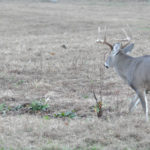
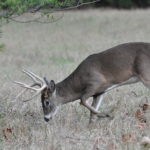



Be the first to comment